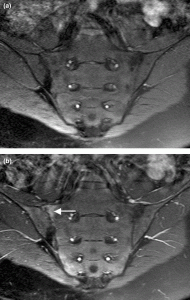
This week’s Know a Procedure deals with a joint we’ll wager you don’t think of that often: your sacroiliac joints, or the joint where your spine meets your pelvis. It may not bend with you the same ways as your fingers do every time you type or your knees when you dance, but it plays in important role in your ability as a human to do important stuff like, bear the load it takes to stand up and walk around on two legs. Treatment of these joints becomes important fast when the act of simply sitting down turns problematic.
Typically, sacroilitis – inflammation or irritation of the sacroiliac joints – occurs via traumatic injury or later in life due to arthritis, notably in women who’ve had children as the joints go through an expansion period during pregnancy to accommodate childbirth.
According to the Mayo Clinic, treatment options range from the following:
Anesthetic injections
Because low back pain can be caused by so many different types of problems, your doctor may suggest using injections of anesthetics to help pinpoint the diagnosis. For example, if an injection of numbing medicine into your sacroiliac joint stops your pain, it’s likely that the problem is in your sacroiliac joint. However, the numbing medicine can leak into nearby structures, and that can reduce the reliability of this test.
The type of treatment your doctor will recommend depends on the signs and symptoms you’re having, as well as the underlying cause of your sacroiliitis.
Medications
Depending on the cause of your pain, your doctor may recommend:
- Pain relievers. If over-the-counter pain medications don’t provide enough relief, your doctor may prescribe stronger versions of these drugs. Occasionally, a short course of narcotics may be prescribed. Narcotics are habit-forming and shouldn’t be used for long periods of time.
- Muscle relaxants. Medications such as cyclobenzaprine (Flexeril, Amrix) may help reduce the muscle spasms often associated with sacroiliitis.
- TNF inhibitors. Tumor necrosis factor (TNF) inhibitors — such as etanercept (Enbrel), adalimumab (Humira) and infliximab (Remicade) — often help relieve the type of sacroiliitis that’s associated with ankylosing spondylitis.
Therapy
Your doctor or physical therapist can help you learn range-of-motion and stretching exercises to maintain joint flexibility, and strengthening exercises to give your muscles additional stability.
Surgical and other procedures
If other methods haven’t relieved your pain, you doctor might suggest:
- Joint injections. Corticosteroids can be injected directly into the joint to reduce inflammation and pain. But you can receive only a few joint injections a year because the steroids can weaken your joint’s bones and tendons.
- Radiofrequency denervation. Radiofrequency energy can damage or destroy the nerve tissue causing your pain.
- Electrical stimulation. Implanting an electrical stimulator into the sacrum may help reduce pain caused by sacroiliitis.
- Joint fusion. Although surgery is rarely used to treat sacroiliitis, fusing the two bones together with metal hardware can sometimes relieve sacroiliitis pain.
Home treatments for sacroiliitis pain include:
- Over-the-counter pain relievers. Drugs such as ibuprofen (Advil, Motrin IB, others) and acetaminophen (Tylenol, others) may help relieve pain associated with sacroiliitis. Some of these drugs can cause stomach upset, or kidney or liver problems.
- Rest. Modifying or avoiding the types of activities that aggravate your pain may help reduce the inflammation in your sacroiliac joints. Proper posture is important.
- Ice and heat. Alternating ice and heat may help relieve sacroiliac pain.
CLICK HERE to read more from the Mayo Clinic about Sacroiliitis.
If you’re experiencing pain in your lower back or hips, Sched







